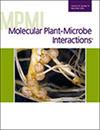Katherine Rivera-Zuluaga, Pratibha Choudhary, Sana Mohammad, Denise Caldwell, Rebecca Leuschen-Kohl, Pete E Pascuzzi, Anjali Iyer-Pascuzzi
求助PDF
{"title":"Pleiotropic Phenotypes of the Tomato <i>diageotropica</i> Mutant Enable Resistance to <i>Ralstonia solanacearum</i>.","authors":"Katherine Rivera-Zuluaga, Pratibha Choudhary, Sana Mohammad, Denise Caldwell, Rebecca Leuschen-Kohl, Pete E Pascuzzi, Anjali Iyer-Pascuzzi","doi":"10.1094/MPMI-10-24-0123-R","DOIUrl":null,"url":null,"abstract":"<p><p>Quantitative disease resistance (QDR) is the most common form of disease resistance in crops, but it is challenging to understand at the cellular level due to the involvement of many genes and biological processes. <i>Ralstonia solanacearum</i>, the causal agent of bacterial wilt disease, is a destructive plant pathogen of Solanaceous species that is best controlled by quantitatively resistant varieties, but few QDR genes are known. We previously found that a tomato auxin pathway mutant known as <i>diageotropica</i> (<i>dgt</i>) has enhanced resistance to <i>R. solanacearum</i>. Here, we show that, as with wild-type quantitatively resistant tomato plants, resistance in <i>dgt</i> is the result of multiple mechanisms. Mock-inoculated <i>dgt</i> roots have endogenously higher levels of the plant defense hormone salicylic acid (SA). However, the SA-deficient double mutant <i>dgtNahG</i> is still resistant to <i>R. solanacearum</i>, indicating that SA-independent pathways are also required for resistance. Scanning electron microscopy revealed that <i>R. solanacearum</i> colonization of the root xylem is delayed in <i>dgt</i>. We found an increased number of lignified xylem cells and altered root vasculature anatomy in <i>dgt</i>, and <i>dgt</i> root length was not impacted by <i>R. solanacearum</i> treatment. Similar to the wilt-resistant wild-type tomato Hawaii7996, RNA sequencing results suggested that <i>dgt</i> may tolerate <i>R. solanacearum</i>-induced water stress better than the wilt-susceptible parent. Thus, resistance in <i>dgt</i> is due to several pathways, including preactivated SA defenses, physical barriers in the xylem, and an ability to tolerate water stress. The pleiotropic nature of this single mutation appears to mimic quantitative resistance. [Formula: see text] Copyright © 2025 The Author(s). This is an open access article distributed under the CC BY-NC-ND 4.0 International license.</p>","PeriodicalId":19009,"journal":{"name":"Molecular Plant-microbe Interactions","volume":" ","pages":"566-578"},"PeriodicalIF":3.4000,"publicationDate":"2025-07-01","publicationTypes":"Journal Article","fieldsOfStudy":null,"isOpenAccess":false,"openAccessPdf":"","citationCount":"0","resultStr":null,"platform":"Semanticscholar","paperid":null,"PeriodicalName":"Molecular Plant-microbe Interactions","FirstCategoryId":"99","ListUrlMain":"https://doi.org/10.1094/MPMI-10-24-0123-R","RegionNum":3,"RegionCategory":"生物学","ArticlePicture":[],"TitleCN":null,"AbstractTextCN":null,"PMCID":null,"EPubDate":"2025/8/11 0:00:00","PubModel":"Epub","JCR":"Q2","JCRName":"BIOCHEMISTRY & MOLECULAR BIOLOGY","Score":null,"Total":0}
引用次数: 0
引用
批量引用
Abstract
Quantitative disease resistance (QDR) is the most common form of disease resistance in crops, but it is challenging to understand at the cellular level due to the involvement of many genes and biological processes. Ralstonia solanacearum , the causal agent of bacterial wilt disease, is a destructive plant pathogen of Solanaceous species that is best controlled by quantitatively resistant varieties, but few QDR genes are known. We previously found that a tomato auxin pathway mutant known as diageotropica (dgt ) has enhanced resistance to R. solanacearum . Here, we show that, as with wild-type quantitatively resistant tomato plants, resistance in dgt is the result of multiple mechanisms. Mock-inoculated dgt roots have endogenously higher levels of the plant defense hormone salicylic acid (SA). However, the SA-deficient double mutant dgtNahG is still resistant to R. solanacearum , indicating that SA-independent pathways are also required for resistance. Scanning electron microscopy revealed that R. solanacearum colonization of the root xylem is delayed in dgt . We found an increased number of lignified xylem cells and altered root vasculature anatomy in dgt , and dgt root length was not impacted by R. solanacearum treatment. Similar to the wilt-resistant wild-type tomato Hawaii7996, RNA sequencing results suggested that dgt may tolerate R. solanacearum -induced water stress better than the wilt-susceptible parent. Thus, resistance in dgt is due to several pathways, including preactivated SA defenses, physical barriers in the xylem, and an ability to tolerate water stress. The pleiotropic nature of this single mutation appears to mimic quantitative resistance. [Formula: see text] Copyright © 2025 The Author(s). This is an open access article distributed under the CC BY-NC-ND 4.0 International license.

 求助内容:
求助内容: 应助结果提醒方式:
应助结果提醒方式:


